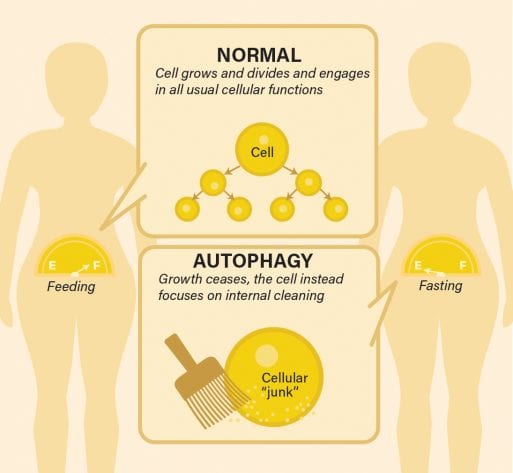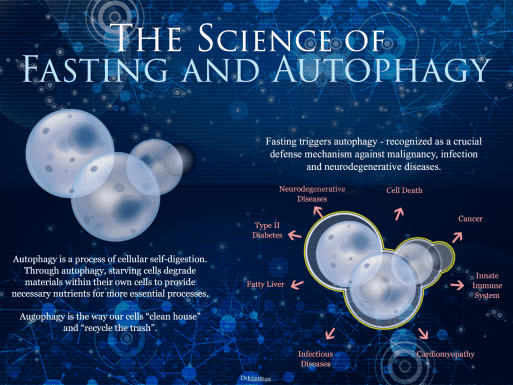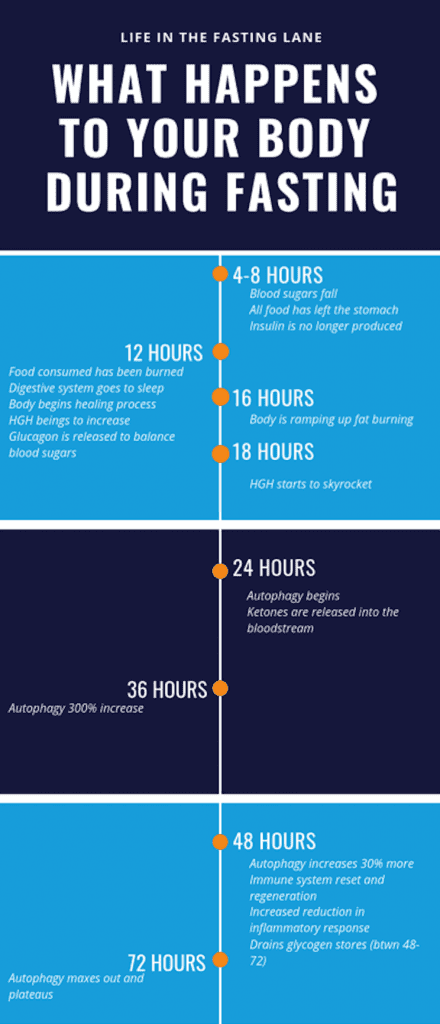
Fasting or caloric restriction triggers autophagy, which could promote longevity in humans
Credit: discovermagazine.com
A research team from the French Medical Research Council (INSERM) has identified a possible caloric restriction mimetic (CRM). As the name suggests, CRMs mimic the effects that caloric restriction and fasting have on our body’s cells without an actual reduction in food intake. CRMs can be either natural or synthetic compounds. The substance identified in the study is called 3,4-dimethoxychalcone (3,4-DC).
Caloric restriction has been shown to extend lifespans in bacteria and animal models. Tests on different yeasts, worms and mice have demonstrated anti-aging effects of CRMs like spermidine and resveratrol. Spermidine has been shown to be associated with reduced cardiovascular and cancer-related mortality, as well as promoting longevity in humans.
The beneficial effect of caloric restriction is derived mainly from a process called “autophagy.” Literally meaning “self-eating,” it is a method by which cells “eat” themselves and engage in self-induced, internal cleaning. The process is jump-started when there are no external food sources. Old cells “clean house” and are recycled to create healthier and better versions of themselves. “Unnecessary” or “dysfunctional” cells are disassembled during autophagy. These kinds of cells could be cancerous or lead to other kinds of illness.
The Study
The research team, led by Oliver Kepp and Guido Kroeme, wanted to uncover new caloric restriction mimetics. They experimented with roughly 200 compounds that belong in the same classification as spermidine and resveratrol. The team tested to find out which substances caused chemical reactions characteristic of increased autophagy in both rat and human cell cultures. They also needed to identify compounds that were not toxic to the cells.

Credit: drjockers.com
The compound 3,4-DC emerged as the most promising agent that mimics caloric restriction to promote autophagy. The researchers noted, however, that 3,4-DC induces autophagy via a different pathway than spermidine and resveratrol.
Researchers proceeded to test the substance on live animals. They injected 3,4-DC into mice and found that it protected against heart attacks when the animals were subjected to cardiac ischemia. The compound also reduced the growth of tumors in the presence of certain chemotherapeutic agents. Both of these effects have been connected with autophagy and caloric restriction mimetics like spermidine and resveratrol.
What It Means
The impact that 3,4-DC could have on humans and whether those effects would be similar to the ones shown in mice has yet to be studied. However, the team’s approach seems to be a legitimate way to determine potential caloric restriction mimetic candidates.
This is important because of the health benefits that CRMs could provide. It’s clear that autophagy is a way for our bodies to rid themselves of “dirty” or potentially cancerous cells. Fasting or engaging in caloric restriction is one way to achieve autophagy. Taking CRMs is another.
The trouble with fasting is that it’s hard to determine exactly when autophagy begins, as far as the time-table goes. Most caloric-restriction-induced autophagy studies have been conducted on animals.
An article from thecut.com quotes nephrologist and fasting researcher Jason Fung: [Autophagy] happens “probably in the later stages of a long fast — somewhere around 20 to 24 hours, is my guess, and it probably maxes out somewhere around 32 hours, again is my best guess.”
Caloric restriction mimetics are essentially a way to help ensure that autophagy occurs. All of this research is beneficial in the fight against diseases people may develop at later stages in life, cancer included. The study concludes that compound 3,4-DC may be a novel CRM to aid in disease and cancer treatments.

 Caloric Restriction, Autophagy, and the Effects on Aging
Caloric Restriction, Autophagy, and the Effects on Aging



 “Help Me, Helen”
“Help Me, Helen”
 Recovering Cremation Remains After the Los Angeles Fires
Recovering Cremation Remains After the Los Angeles Fires
 “As Tears Go By” by Marianne Faithfull
“As Tears Go By” by Marianne Faithfull














